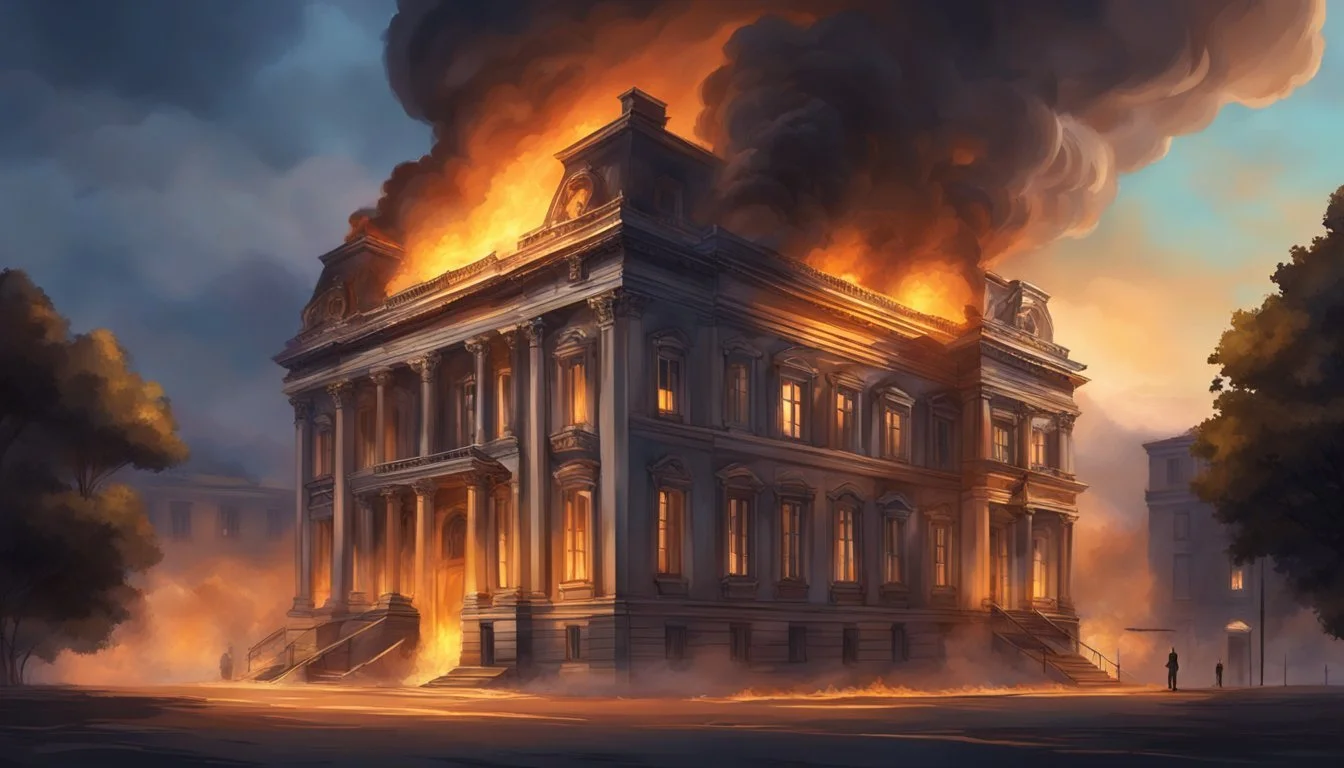The Burning by Tim Madigan: A Harrowing Account of the 1921 Tulsa Race Massacre
Tim Madigan's "The Burning" sheds light on a dark chapter of American history - the Tulsa Race Massacre of 1921. This meticulously researched book recounts the events that led to the destruction of Greenwood, a thriving Black community in Tulsa, Oklahoma.
On June 1, 1921, a white mob attacked Greenwood, burning it to the ground and killing hundreds of Black residents. Madigan's work brings this often-overlooked tragedy to the forefront, examining the racial tensions and societal factors that culminated in this horrific event.
Through compelling storytelling and thorough historical analysis, "The Burning" offers readers a profound understanding of this pivotal moment in American race relations. Madigan's clear-eyed approach and attention to detail make this book an essential read for those seeking to comprehend the long-lasting impacts of racial violence in the United States.
Historical Context of 'The Burning'
The early 20th century in America was marked by racial tensions, segregation, and violence against Black communities. This period saw both the rise of prosperous Black enclaves and devastating racial attacks.
Jim Crow and Racism in American History
Jim Crow laws enforced racial segregation across the Southern United States from the late 19th century until 1965. These laws restricted Black Americans' rights and opportunities in education, employment, and housing.
Black citizens faced systemic discrimination and the constant threat of violence. Lynchings and race riots occurred with alarming frequency during this era.
The rise of white supremacist groups like the Ku Klux Klan further fueled racial hostilities. Many white Americans viewed Black success and autonomy as a threat to the established social order.
Greenwood: The Black Wall Street
Tulsa's Greenwood District, known as "Black Wall Street," was a thriving center of Black entrepreneurship and prosperity in the early 1920s. The area boasted successful Black-owned businesses, including hotels, theaters, and medical practices.
Greenwood's affluence stood in stark contrast to many struggling white communities nearby. The district became a symbol of Black economic independence and self-sufficiency.
This success, however, bred resentment among some white Tulsans. Racial tensions simmered beneath the surface, setting the stage for conflict.
The Tulsa Race Riot of 1921
On May 31, 1921, rumors spread that a young Black man had assaulted a white woman in an elevator. This accusation ignited existing racial tensions in Tulsa.
A white mob gathered outside the courthouse where the accused was held. Armed Black men arrived to protect him, leading to a confrontation.
Over the next 24 hours, white rioters looted and burned Greenwood to the ground. They killed hundreds of Black residents and left thousands homeless.
The destruction of "Black Wall Street" marked one of the worst incidents of racial violence in American history. It devastated Tulsa's Black community and erased decades of economic progress.
Overview of 'The Burning'
Tim Madigan's "The Burning" recounts the devastating 1921 Tulsa Race Massacre, exploring its causes and consequences. The book provides a detailed examination of the events that led to the destruction of Greenwood, a prosperous Black community in Tulsa.
Author's Perspectives
Madigan approaches the subject with meticulous research and a commitment to uncovering long-buried truths. He reconstructs the racial atmosphere of post-World War I America, particularly in Tulsa. The author's narrative style brings the thriving Greenwood district, known as "Black Wall Street," to life.
Madigan's account is praised for its clarity and skillful storytelling. Adam Nossiter of The New York Times Book Review describes it as "a powerful book" and "a harrowing case study." The author's perspective emphasizes the importance of acknowledging this tragic chapter in American history.
Major Themes and Narratives
The book centers on the events of June 1, 1921, when a white mob attacked Greenwood. Madigan details the massacre's buildup, execution, and aftermath. He explores themes of racial tension, economic disparity, and the power of mob mentality.
"The Burning" examines the destruction of 34 square blocks of Greenwood, highlighting the community's prosperity before the attack. The narrative covers the mob's actions, the resistance of Greenwood's residents, and the long-term impact on Tulsa and race relations in America.
Madigan also delves into the subsequent cover-up and long silence surrounding the massacre. He emphasizes the importance of confronting difficult historical truths for healing and progress.
Unfolding the Tragedy
The Tulsa Race Riot of 1921 stands as one of the darkest chapters in American history. It exemplifies the devastating consequences of unchecked racial hatred and violence.
The Onset of the Racial Massacre
On May 31, 1921, tensions in Tulsa, Oklahoma reached a boiling point. A young Black man named Dick Rowland was accused of assaulting a white woman in an elevator. This accusation sparked rumors and inflamed existing racial tensions.
A mob of white men gathered outside the courthouse, demanding Rowland be handed over. Armed Black men arrived to protect Rowland from potential lynching. As tensions escalated, a shot was fired.
This single gunshot triggered a full-scale assault on Tulsa's Greenwood District, known as "Black Wall Street" due to its thriving Black-owned businesses and affluent residents.
The Impact of Hatred and Racism
The white mob's actions were fueled by deep-seated racism and resentment towards the successful Black community. They looted homes and businesses, set fire to buildings, and attacked Black residents indiscriminately.
Law enforcement did little to stop the violence. Some reports suggest that some police officers even participated in the destruction. The National Guard was called in, but their primary focus was on disarming and detaining Black residents.
The rioters used private aircraft to drop firebombs on buildings, marking one of the first aerial attacks on U.S. soil. This tactic devastated large portions of Greenwood.
Account of Casualties and Destruction
The true extent of the casualties remains uncertain due to incomplete records and cover-ups. Estimates range from 30 to 300 deaths, with most victims being Black residents.
The material destruction was staggering:
35 blocks of Greenwood were reduced to ashes
Over 1,200 homes were destroyed
Hundreds of businesses were obliterated
Schools, churches, and a hospital were burned down
Thousands of Black residents were left homeless. Many fled Tulsa, never to return. The economic impact on the Black community was severe, erasing generations of wealth and prosperity.
Aftermath and Legacy
The 1921 Tulsa Race Massacre left deep scars on the Greenwood community and shaped public policy responses. Efforts for restitution and justice emerged alongside investigations into the tragedy's causes and consequences.
Physical and Emotional Scars
The destruction of Greenwood left lasting physical and emotional wounds. Over 35 city blocks were burned, displacing thousands of Black residents. Many survivors lost homes, businesses, and life savings.
The trauma of the violence lingered for decades. Survivors and their descendants experienced nightmares, anxiety, and depression. Some never spoke of the events, burying the pain deep inside.
Rebuilding efforts faced significant challenges. Insurance companies often refused to pay claims, citing riot clauses. Many residents left Tulsa, never to return.
Quest for Restitution and Justice
Survivors and descendants sought recognition and compensation for their losses. Legal efforts faced numerous obstacles, including statutes of limitations and sovereign immunity claims.
In 2003, a federal lawsuit was filed on behalf of survivors. It was ultimately dismissed in 2004. Other attempts at restitution through legislation also failed to gain traction.
Some argue that true justice remains elusive. The full extent of lives lost and property destroyed may never be known.
Public Policy Response
In the massacre's immediate aftermath, city officials largely downplayed or ignored the event. No criminal prosecutions occurred for the deaths and destruction.
Tulsa's Black community rebuilt Greenwood without government assistance. However, discriminatory zoning laws and redlining practices hindered full recovery.
It wasn't until decades later that public acknowledgment began. In 1997, the Oklahoma Legislature created the Tulsa Race Riot Commission to investigate the events.
The Tulsa Race Riot Commission
The commission's work marked a turning point in public recognition of the massacre. Their 2001 report provided a comprehensive account of the events and their impact.
Key findings included:
Confirmation of mass graves
Evidence of complicity by some local officials
Recommendations for reparations to survivors and descendants
The commission's work led to increased education efforts. Oklahoma schools now include the massacre in state history curricula.
While the commission's recommendations weren't fully implemented, its report remains a crucial resource for understanding the tragedy's scope and legacy.
Addressing the Racial Past
The Tulsa Race Massacre of 1921 serves as a stark reminder of America's troubled racial history. It highlights the need for confronting past injustices and working towards meaningful reconciliation.
Challenges in Racial Reconciliation
Addressing historical racial atrocities presents significant challenges. Many communities struggle to acknowledge painful pasts, fearing reopened wounds or legal repercussions.
The Tulsa massacre remained largely hidden from public consciousness for decades. This erasure compounded the trauma for survivors and their descendants.
Effective reconciliation requires honest dialogue, education, and a willingness to confront uncomfortable truths. It demands sustained effort from both individuals and institutions.
Learning from a Tragic Example
The destruction of Tulsa's Greenwood district offers critical lessons for modern race relations. It demonstrates how quickly prosperity can be shattered by racial hatred and violence.
Greenwood's success as "Black Wall Street" challenged white supremacist narratives. This perceived threat led to its brutal annihilation.
Studying this tragedy can inform current efforts to combat systemic racism and promote equity. It underscores the importance of protecting minority communities and their economic progress.
A Case Study in Systemic Racism
The Tulsa massacre exemplifies how racism can be deeply embedded in societal structures. Local authorities not only failed to prevent the violence but actively participated in it.
Law enforcement deputized white mob members
The National Guard imprisoned Black survivors rather than protecting them
Insurance companies denied claims, citing "riot" clauses
In the aftermath, no white perpetrators faced charges. Black residents struggled to rebuild without compensation or support.
This systemic failure at multiple levels illuminates how racism can permeate institutions, hindering justice and perpetuating inequality.
Appendix
This section provides detailed chapter notes and references for "The Burning" by Tim Madigan. It offers readers additional context and source information to support the book's historical account.
Chapter Notes and References
The chapter notes in "The Burning" offer valuable insights into Madigan's research process and sources. Each chapter is meticulously annotated, providing citations for quoted material and background information.
The notes include references to primary sources such as newspaper articles, official reports, and firsthand accounts from survivors of the Tulsa Race Massacre. Madigan also cites secondary sources, including academic works and historical analyses.
Many entries provide additional context not included in the main text. These notes offer readers the opportunity to delve deeper into specific aspects of the event and its aftermath.
The references section lists all sources consulted by Madigan during his research. It includes books, articles, archival materials, and personal interviews. This comprehensive bibliography serves as a valuable resource for readers interested in further study of the Tulsa Race Massacre.





